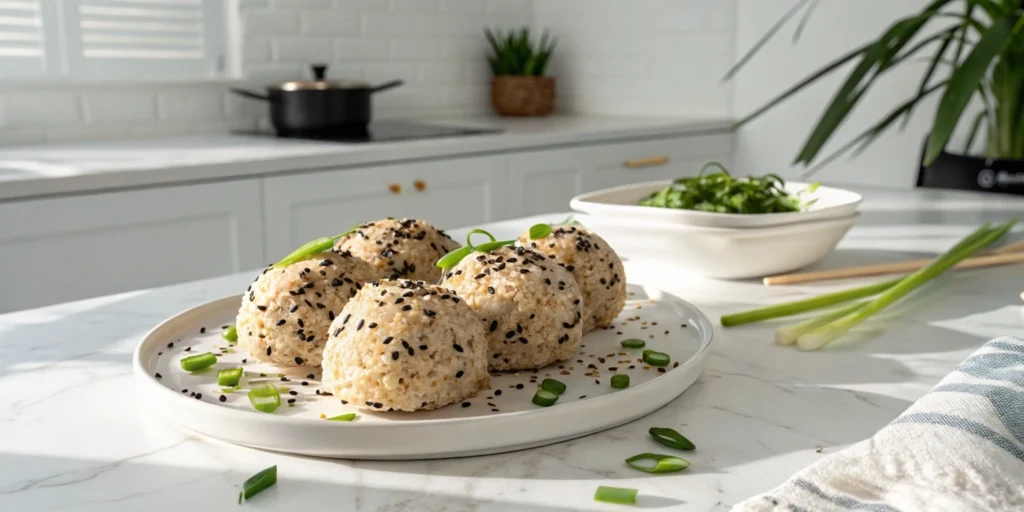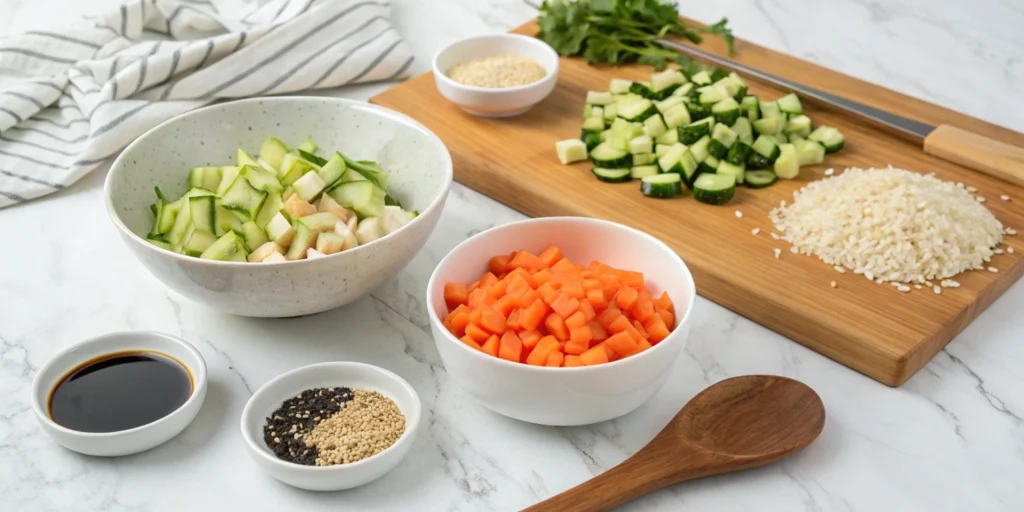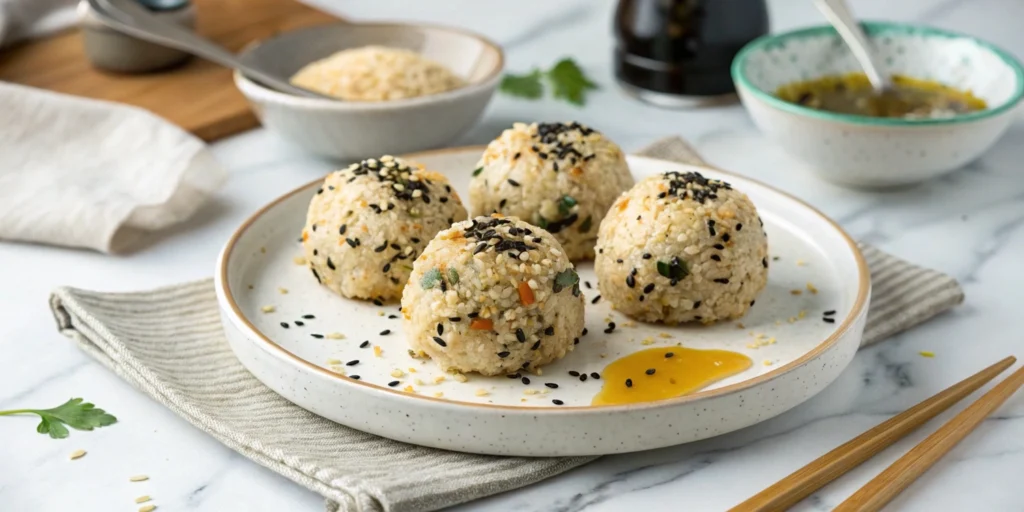
Table of Contents
Jumeokbap (주먹밥) vegan is a beloved Korean dish that embodies simplicity and comfort. Translated as “fist rice,” this dish consists of rice mixed with various seasonings and ingredients, shaped into balls by hand. Traditionally, jumeokbap is packed with protein and flavors that reflect Korean culinary roots, but today, we’re exploring a plant-based version that’s just as satisfying and even healthier. Whether you’re looking for a quick meal or a snack to take on the go, this vegan version will leave you feeling nourished and content.
In this article, you’ll learn how to make Light & Easy Vegan Jumeokbap in 10 Steps. From understanding the dish’s cultural significance to perfecting your technique, we’ll cover everything you need to know to create this delicious meal. Along the way, we’ll share helpful tips, nutrition facts, and ideas for variations so that you can tailor the dish to your tastes. Let’s get started!
What is Jumeokbap Vegan Recipe?
Jumeokbap (주먹밥) is a traditional Korean dish known for its versatility and simple, yet satisfying flavors. The dish consists of steamed rice mixed with a variety of ingredients such as vegetables, pickles, or protein sources, and shaped into a ball. It’s considered a type of doshirak, a Korean lunchbox meal that can be easily packed and taken anywhere, making it ideal for picnics, work lunches, or quick snacks.
The name “jumeokbap” literally translates to “fist rice” because of the way the rice is molded into small, compact balls by hand. Traditionally, these rice balls are filled with meat, seafood, or egg, but today, many people choose to make vegan versions that are just as flavorful and satisfying. The beauty of jumeokbap lies in its adaptability. You can fill it with whatever you have on hand, creating a dish that fits your dietary needs while staying true to the core essence of Korean comfort food.
Why You’ll Love This Recipe
Health Benefits of Vegan Jumeokbap
The vegan version of jumeokbap is an excellent choice for anyone looking to enjoy a light yet satisfying meal. Here are a few reasons why you’ll love it:
- Low in Saturated Fats: Since this recipe doesn’t use any animal products, it’s naturally lower in saturated fats, making it a heart-healthy option.
- Packed with Fiber: The inclusion of vegetables like carrots and zucchini increases the fiber content, helping with digestion and promoting gut health.
- Rich in Nutrients: With ingredients like sesame oil, rice, and vegetables, this dish provides a range of nutrients, including antioxidants, vitamins, and minerals.
- Customizable: Whether you follow a gluten-free, soy-free, or low-carb diet, this recipe can be adapted to suit your needs without compromising on flavor.
Quick and Simple Preparation
One of the best things about vegan jumeokbap is how easy and quick it is to prepare. You don’t need any special tools or hard-to-find ingredients. In just 10 simple steps, you’ll have a batch of delicious rice balls ready to serve. Plus, it’s a perfect meal-prep option. You can make a large batch and enjoy it over the course of a few days.
Ingredients for Vegan Jumeokbap
To make this vegan jumeokbap recipe, you’ll need the following ingredients:

- 2 cups cooked short-grain rice
Short-grain rice works best because it’s stickier than long-grain rice, making it easier to form into rice balls. - 1/4 cup finely diced carrots
Carrots add a pleasant crunch and a touch of sweetness to balance the flavors. - 1/4 cup finely diced zucchini
Zucchini is mild and adds a fresh, light texture to the rice balls. - 1 tablespoon sesame oil
Sesame oil adds a rich, nutty flavor that is essential to the dish’s authentic taste. - 1 tablespoon toasted sesame seeds
These seeds bring a satisfying crunch and enhance the flavor profile. - Salt to taste
Adjust the seasoning to your liking.
Feel free to get creative and add other ingredients, such as pickled radish, tofu, or a sprinkle of nutritional yeast for extra flavor.
Light & Easy Vegan Jumeokbap Recipe: Step-by-Step
Now that you have all your ingredients ready, it’s time to dive into making these delicious vegan rice balls. Here are the 10 easy steps to follow:
Step 1: Prepare the Vegetables
Start by washing and peeling your vegetables. Dice the carrots and zucchini into small pieces. The smaller the dice, the better they’ll blend with the rice. You can also experiment with other vegetables, such as spinach or bell peppers.
Step 2: Cook the Vegetables
Heat a pan over medium heat and add a small amount of oil (about 1 tsp). Sauté the carrots, zucchini, and any other vegetables you’re using. Cook them until they’re tender, about 5-7 minutes. Set them aside to cool down before mixing them with the rice.
Step 3: Cook the Rice
Prepare 2 cups of short-grain rice. You can cook it in a rice cooker, stovetop, or pressure cooker, depending on your preferred method. After cooking the rice, allow it to cool for a few minutes. It’s important that the rice isn’t too hot when you start making the rice balls, so it’s easier to handle.
Step 4: Season the Rice
When the rice has cooled down a bit, move it to a large mixing bowl. Drizzle the sesame oil over the rice and sprinkle a pinch of salt. Mix well so that the rice is evenly coated. The sesame oil is what brings the signature Korean flavor to jumeokbap, so don’t skip this step!
Step 5: Combine the Ingredients
Add the sautéed vegetables to the rice and stir to combine. Make sure the vegetables are evenly distributed throughout the rice mixture. You can also add other seasonings or ingredients at this point, like a spoonful of soy sauce or a dash of pepper.
Step 6: Shape the Rice Balls
Dampen your hands with water to stop the rice from sticking. Take a small handful of the rice mixture and gently shape it into a compact ball, about the size of a small fist. Continue shaping the rice balls until all of the rice mixture is finished. You should get about 6-8 rice balls depending on the size.

Step 7: Optional Add-Ons
At this point, you can get creative. You can roll the rice balls in toasted sesame seeds, nori strips, or even crushed peanuts for added texture. If you want some heat, a drizzle of gochujang (Korean red pepper paste) will give the rice balls a spicy kick.
Step 8: Chill the Rice Balls
Place the rice balls in the refrigerator for 10–15 minutes to help them hold their shape. This step is optional but helps the rice balls stay firm, especially if you’re packing them for lunch.
Step 9: Serve and Garnish
Once the rice balls have chilled and firmed up, serve them on a plate. You can garnish them with more sesame seeds, sliced scallions, or a drizzle of sesame oil for added flavor.

Step 10: Enjoy!
These vegan jumeokbap are perfect for a quick meal or snack. Pack them in your lunchbox for an easy-to-carry, plant-based meal or enjoy them as part of a larger Korean-inspired feast.
Tips for Perfect Vegan Jumeokbap Every Time
- Use Sticky Rice: For the best texture, always use short-grain or medium-grain rice. This type of rice will stick together well, making it easier to form the rice balls.
- Don’t Overcook the Vegetables: The vegetables should be cooked until tender but not mushy. You want them to hold their shape when mixed with the rice.
- Add Protein: For an added nutritional boost, try adding tofu, edamame, or chickpeas to the rice mixture for plant-based protein.
- Experiment with Flavors: You can season the rice with different spices, such as garlic powder, onion powder, or even a little bit of curry powder for a unique twist.
Frequently Asked Questions (FAQ)
Can I use brown rice instead of white rice for vegan jumeokbap?
Yes, you can! Brown rice will give the rice balls a slightly chewier texture and provide more fiber, though the rice balls may be a bit less sticky. Just ensure the rice is cooked properly so it holds together when shaping.
How long can I store vegan jumeokbap?
Vegan jumeokbap can be stored in an airtight container in the refrigerator for up to 3 days. If you’d like to keep them longer, you can freeze the rice balls and reheat them when needed.
What other vegetables work well in jumeokbap?
Spinach, bell peppers, and even mushrooms are great additions to vegan jumeokbap. Get creative with whatever you have on hand.
Conclusion
Vegan jumeokbap is a perfect dish for those looking to enjoy a light, healthy, and comforting meal. It’s quick to prepare, highly customizable, and bursting with delicious flavors. Whether you’re new to Korean cuisine or already a fan of plant-based meals, this recipe is a great way to enjoy the traditional taste of Korea in a vegan-friendly form. So grab your ingredients, follow these 10 easy steps, and enjoy your very own batch of homemade vegan jumeokbap!
Ready to make your own vegan jumeokbap? Share your creations in the comments or tag us on social media—we’d love to see how you make this dish your own!
